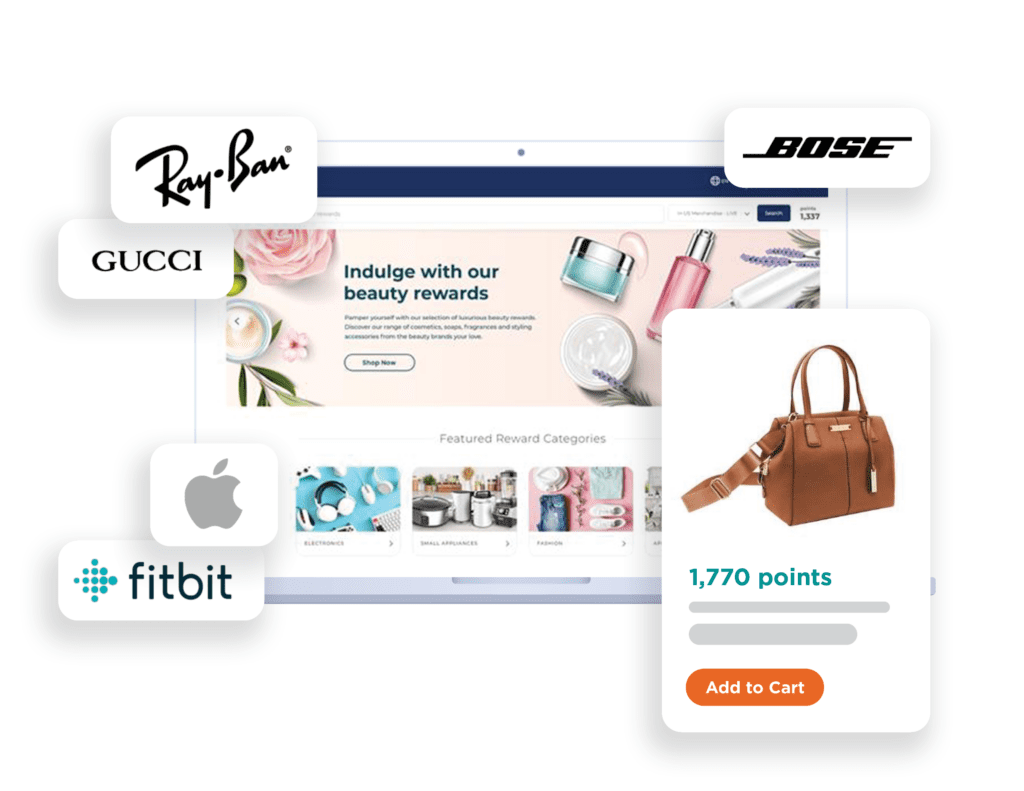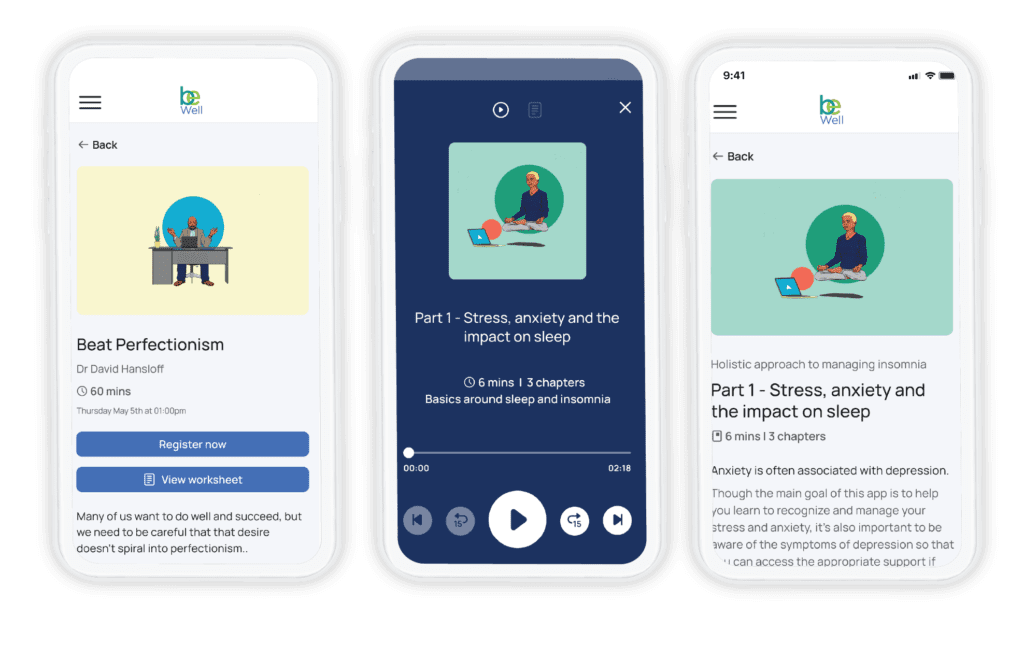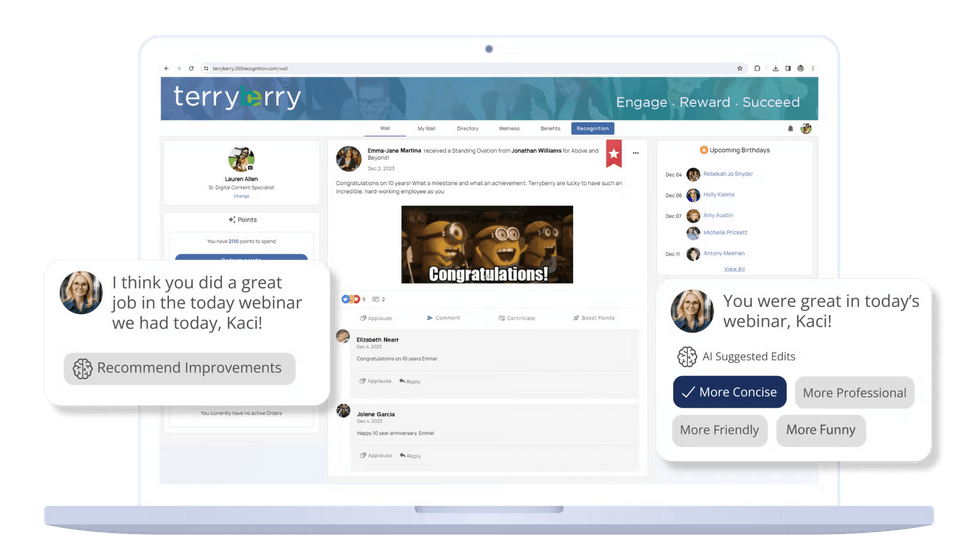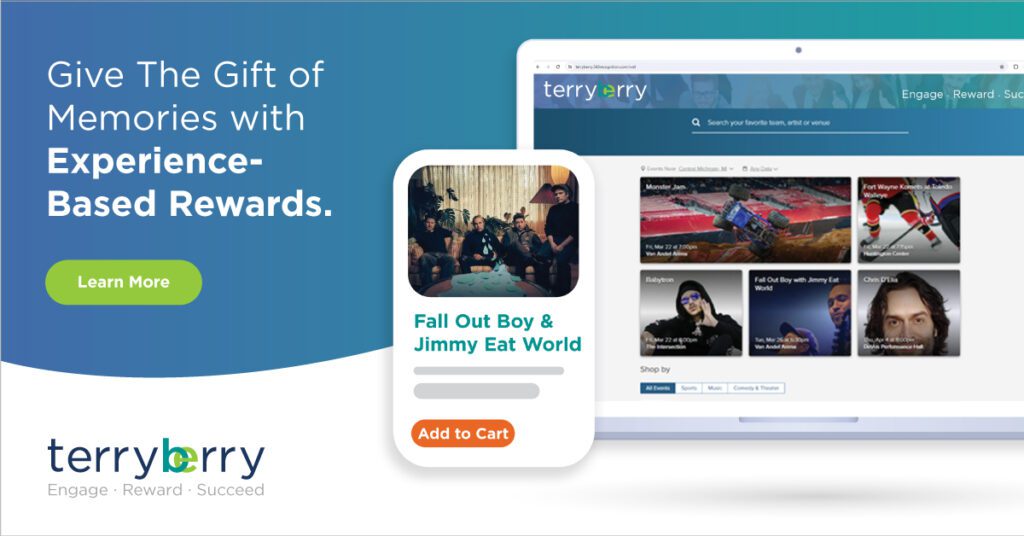August 8, 2025

Employee incentive programs aren’t a nice-to-have—they’re a need-to-have.
Let’s face it: work is hard. There’s no getting around it. Employees show up and put in their time ~260 days a year, and (no matter what kind of job or industry) it eventually starts to take a toll.
But employees and employers want more than that—you want more than that. While a paycheck and health benefits are top priorities, they’re not all that matters. According to Gartner, employees increasingly want to:
- Feel valued
- Create an impact
- Be acknowledged
- Be empowered
- Feel trusted
- Be respected
A strong company culture and a focus on work-life balance are also becoming essential for today’s workforce. Employees are looking for workplaces that support their well-being and align with their values.
Beyond pay and benefits, flexible hours and support for personal life are key factors in employee satisfaction and retention. These elements help employees manage their responsibilities both at work and at home, leading to greater engagement and loyalty.
Fortunately, you have the power to make that happen.
You can take steps to boost engagement and make your work environment a better place. And one way to do that is with employee incentive programs.
What is an Employee Incentive Program?
An employee incentive program is a system designed to motivate and reward employees for meeting business and personal goals. Now, these are extra perks.
Employees receive a salary and employee benefits just for showing up and doing their job—employee incentive programs are distinct from employee benefits, as they are designed to inspire your workforce to go above and beyond their job descriptions.
There are no one-size-fits-all goals or incentives. The purpose, scope, and rewards will all be specific to your unique industry, situation, and workforce. Using an employee survey can help you identify what motivates your employees, tailor your incentive programs, and improve employee satisfaction.
For example, your employees might be overworking themselves and neglecting their health, and the sick days could add up and lead to long-term burnout and attrition.
A wellness incentive program could inspire your employees to participate in a daily steps challenge or healthy-eating challenge by rewarding them with gym passes, health gadgets, or meal box subscriptions.
Do Employee Incentive Programs Work?
Employee incentive programs can be a powerful culture-building tool. However, they’re not a standalone fix-all solution. Incentives won’t cover up a toxic work environment or internal problems that need fixing.
But, used in conjunction with open feedback and communication (and a leadership team that cares), employee incentive programs can provide plenty of benefits:
- Drive engagement and productivity
- Boost employee morale and satisfaction
- Decrease employee turnover
- Improve health and wellness
- Build your brand
Effective employee incentive programs are designed to boost employee motivation and enhance organizational performance by linking rewards to meaningful goals and fostering a positive workplace culture.
Employee incentive programs best work when you tie the incentive to the behavior. That’s easier said than done, and you’ll need to do some work to identify the right program fit. Implementing effective incentive programs that align with company goals is essential for maximizing their impact.
For example, if your sales team underperformed last quarter, a hiring referral program or wellness initiative wouldn’t solve the issue—you’d need to look at a sales incentive program or performance rewards.

The Benefits of Employee Incentive Programs
Employee incentive programs are more than just a workplace perk—they’re a strategic tool for building a thriving organization. When you implement an effective incentive program, you’re not only rewarding employees for their hard work, but also creating an environment where employees feel valued, motivated, and inspired to do their best.
One of the most significant benefits of employee incentive programs is their ability to boost employee morale and engagement.
When employees know their efforts are recognized—whether through monetary incentives like bonuses and profit sharing, or non-monetary incentives such as recognition programs and tuition reimbursement—they’re more likely to stay motivated and committed to the company’s success.
This sense of appreciation can lead to higher employee retention, as team members feel a genuine connection to their workplace and are less likely to seek opportunities elsewhere.
Incentive programs also play a crucial role in fostering a positive work environment. By encouraging employees to collaborate and celebrate each other’s achievements, these programs promote team building and a culture of support.
Recognition programs, for example, help employees feel seen and valued, while career development opportunities and tuition reimbursement show a commitment to their long-term growth.
8 Employee Incentive Ideas to Motivate Your Teams
Below, we’ll cover our favorite employee incentive ideas. Employee incentive plans are designed to keep employees motivated and employees engaged by aligning their goals with organizational objectives.
Remember, quality over quantity. You don’t need to launch every program at your organization—find the programs that best align with your employees’ needs and roll them out one at a time.
1. Create a Sales Incentive Program to Reward Top Performers
If everyone gets compensated equally (regardless of performance), it’s hard to inspire your sales representatives to improve their work. However, just a bit of extra compensation and recognition can be all the catalyst your team needs to get deals across the finish line.
Motivate your sales team to do their best work and blow their goals out of the water with a tailor-made sales incentive program. You might:
- Compensate your top performers with prestigious award packages
- Reward employees when they pass certain sales milestones
- Drive short-term wins with redeemable performance points or gift cards
- Boost your salespeople’s commission percentage if they reach a certain number of sales
- Offer monetary incentives with monetary rewards or monetary bonuses for exceeding sales targets
2. Provide Performance Incentives to Drive Growth
Salespeople aren’t the only employees who benefit from performance incentives. Everyone from your engineers to your marketers to your recruiters can use an extra bit of motivation to do their best work.
You might reward developers who deploy a certain number of pull requests, marketers who generate a certain number of leads, and recruiters who bring in high-value new hires.
Tying incentives to employee performance and annual salary reviews can provide a strong financial incentive for improvement, making rewards more meaningful and directly linked to both achievement and compensation. Rewards could be:
- Bonuses
- Points to redeem for prizes on a reward platform
- Custom awards, like plaques, trophies, or custom jewelry
- Extra paid time off (PTO)
Don’t be afraid to ask employees what they want when building out your rewards. Some teams may care less about the compensation—they might just want recognition and branded prizes. Talk to them before you roll out any incentives to find a program that best aligns with their needs.
3. Build a Culture of Safety With a Safety Incentives Program

Don’t just reward employees for what they do—reward them for what they don’t do. Safety is a top priority at any company, but it often only gets paid lip service. Show your employees what safety means to you with a safety incentive program.
A safety incentive program rewards employees who act to build safe behaviors, reduce accidents, and create a secure working environment. Safer workplaces protect employees, increase productivity, and reduce turnover—employees want to work where they feel safe.
Here are a few indicators you can monitor to reward safe behavior:
- Safety training competition: Incentivize employees to complete safety trainings.
- Incident reporting: See something, say something. Reward employees for being honest and reporting issues.
- Inspection success: Reward teams for proactively making changes and passing the first inspection.
- Time without incidence: Compensate teams that reach significant milestones for time without incidence.
- Group or team incentives: Offer group incentives or team incentives when the entire team achieves safety milestones, promoting collaboration and strengthening team bonds.
These rewards pay for themselves. Work accidents are sad and (most of the time) avoidable—not to mention expensive. Proactively rewarding safe behavior will help you create a culture of security and prevent mistakes.
You could also consider rewarding employees who follow cybersecurity best practices. This is especially important if you have a sizable work-from-home workforce that faces the threat of phishing and hacking rather than physical harm.
4. Prioritize Health With Employee Wellness Incentives
Boost your employees’ physical, mental, emotional, and even social health with employee wellness incentives. When employees know that their work permits (better yet: encourages) taking time for themselves, they’re more likely to take action.
There’s a big difference between a boss who encourages employees to take an exercise break and a boss who rewards employees to take one. There’s no single best way to launch a wellness program, but here are a few wellness ideas to get your creative juices flowing:
- Steps challenge: Set goals for employees to walk a certain number of steps every day or week.
- Yoga sessions: Offer private yoga experiences and reward employees who show up.
- Healthy-eating challenge: Educate employees on healthy eating, provide better in-office snacks, and reward workers who take action.
- Health insurance benefits: Offer comprehensive health insurance as part of your wellness incentives to support employee well-being and security.
Like safety programs, wellness incentives pay for themselves with an average 150% return on investment. Yes, you’ll be giving out prizes and bonus health benefits, but you’ll see fewer sick days, lower healthcare costs, higher performance, and greater employee morale.
Supporting employees' personal lives through wellness initiatives, such as encouraging time off and family-oriented perks, can further improve overall well-being and satisfaction.
Incentives could include:
- Discounts on insurance premiums
- HSA contributions
- Extra PTO
- Gym membership
- Personal trainer lessons
- Wellness app subscriptions
Want a unique customized wellness program that’s easy to use and simple to manage? Check out Terryberry’s employee wellness solutions. Our applications automatically track activity, update leaderboards, and display metrics in a dashboard to make administration downright effortless.
5. Drive Social Engagement With Advocacy Programs
Need help marketing your business but don't have the budget for expensive advertising campaigns? Reward your employees for doing the marketing for you.
Your business can use employee advocacy programs to encourage employees to share content (blog posts, case studies, job openings, company news, and product launches) across their social media followings. Employees share content, earn points, and redeem those points for prizes.
Employee advocacy programs turn every worker into a marketer. If any employee can refer qualified candidates, any employee can generate organic traffic and leads.
It’s a win-win for both you and your employees. You generate curated content for them to share with their networks, and they publish trending news, build their followings, and earn prizes while you gain brand awareness and extended reach. Everyone wins.
6. Acknowledge Publicly With a Recognition Incentive Program
Awards are great, but recognition is sometimes even better. Recognize your employees’ milestones, anniversaries, and performance in a public setting—not just with an email or Slack message.
Consider hosting annual awards for top-performing employees, cultural stewards, and collaborative teams. Present these awards in front of the entire company.
Public recognition through structured recognition programs, such as annual awards or employee of the month, elevates employee motivation and reinforces a culture of appreciation. This helps employees feel acknowledged for going above and beyond and creates a culture of recognition and celebration.
When leadership takes the time to notice contributions (big and small), employees begin doing the same for each other. They celebrate team wins and personal accomplishments. Employee recognition and celebrating employee success can reinforce positive behaviors and inspire ongoing engagement. They motivate each other and aspire to do better.
Use Terryberry’s social recognition software to empower your teams to start celebrating each other. Executives, managers, and colleagues can access the social-media-like platform to share stories, highlight wins, and reward top-notch performance.
7. Reward Employees Who Find Candidates With a Referral Program
Your human resources team is likely doing everything possible to recruit new employees, but sometimes your current staff can dig even deeper.
Your marketing team probably knows a few other marketers, and your software engineers likely have worked with other experienced talent— why not tap into those networks to find your next hire?
It’s not easy, and it’ll take time, so reward your employees for posting job openings on social media and bringing in qualified candidates. Referral prizes could be compensation, redeemable points, or customized awards.
Offering referral bonuses as a form of monetary employee incentives can further motivate staff, providing a tangible reward for successful recommendations.
8. Support Causes Your Employees Care About With Giving Programs
People love helping, especially when it's a good cause. Let your employees have a say in which charities you financially support. They can contribute their own time and resources, and you can do your part with matching incentives or volunteer programs.
Here are a few ideas you can use to launch a giving incentive program:
- Volunteering: Provide your employees with volunteer time off or dedicated volunteer days.
- Matching: Launch a program to match a certain percentage of your employees’ donations to a charity or cause they care about.
- Donating: Reward tenure, performance, and behavior with one-time donations to a charity of the employee's choice.
Build Employee Incentive Programs That Matter
Not every employee incentive program is created equally. Without the right foundation, incentive programs can fall by the wayside and fail to meet your goals. Do it right from the get-go to ensure efficiency and maximum adoption.
Terryberry will help design and implement your employee incentive program from the ground up. We provide the experience, tools, and know-how you need to reward your top performers and drive better engagement.
Employee incentive plans are essential for boosting employee motivation, satisfaction, and retention. There are a variety of options available, including employee stock ownership plans and profit-sharing programs where employees benefit directly from the company's success.
Whether you need to build a sales program, wellness incentives, safety awards, or a recognition program, we can make it happen.
Our programs can also include professional development, professional development opportunities, and career growth initiatives as part of employee incentives to further enhance employee motivation and employee satisfaction.
Schedule a demo with our team to see firsthand how Terryberry can transform your organization’s recognition and employee incentive programs.






